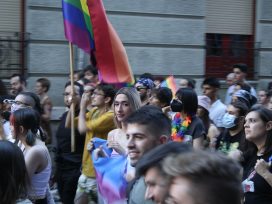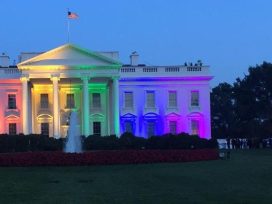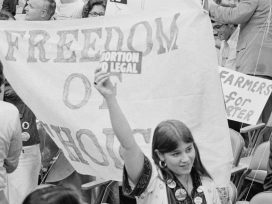The Afrikaner has denied the Coloured mother. He has denied the Coloured originator of his language. Denied the builder of his houses and the fashioner of his furniture. Denied the designer of his clothes and of his silver. Denied the preserver of his music and the creator of his pleasure.
So wrote Marie Kathleen Jeffreys in 1959. Jeffreys (1893-1968) was a “white” woman who worked as an archivist in the Cape Town Archives Repository for twenty-nine years. She used her access to historical documents to undertake and disseminate genealogical studies and historical research that sought to remind a country in the first throes of apartheid legislation of the Creole origins of the South African nation. Apartheid was institutionalized in 1948, with the first National Party election victory. By 1950, the country was enacting Population Registration legislation. Jeffreys sought to counter the separating drive enshrined in the Population Registration Act, thus attempting to force a recognition of the artificiality of apartheid’s social engineering.
She did so by writing articles about the historical figure Krotoa-Eva, who acted as an interpreter between the Dutch and her own people, the indigenous Khoikhoi, in the early Cape settlement, and who was the first indigenous woman to marry into the nascent European settler society. She also examined the social conditions of Krotoa-Eva’s time: she wrote about the institution, and consequences, of slavery. Drawing attention to what was in her own time a repressed history, Jeffreys insisted that the implications of “racial mixing” in the early Dutch settlement at the Cape be acknowledged, along with the Creole cultural forms that sprung from the intimate relations of the slave-holding household.
This article will investigate Jeffreys’s presentation of Krotoa-Eva, exploring the implications for South Africans she found in Krotoa-Eva’s marriage. Identifying the context, intention, and effect of Jeffreys’s work on Krotoa-Eva, we will then turn to post-apartheid South Africa, where Krotoa-Eva has reemerged as a resonant presence. In the eleven years since liberation from minority rule, Krotoa-Eva, largely ignored for most of the preceding three centuries with the occasional exception, such as Jeffreys’s work, has been publicly reclaimed as the autochthonous mother of the “new” South Africa, who grants her white descendents a “legitimate” presence in Africa. Although the context is very different to Jeffreys’s emerging apartheid placement, we will suggest that despite some important differences, many continuities exist between these two acts of retrieving Krotoa-Eva. “White” identity thus continues to elide the violence of its own history in its construction of itself.
To make this point, we examine first Jeffreys’s writings about Krotoa-Eva and then some more recent invocations of this important historical figure. Finally, we place these representations of Krotoa-Eva within the context of slavery in the construction of the South African nation, as discussed by Jeffreys. While Krotoa-Eva, along with other indigenous Khoikhoi, was not herself enslaved, the dominant political economy of slavery at the Cape shaped the discourses and practices of “racial” power in relation to the Khoikhoi, and particularly Khoikhoi women such as Krotoa-Eva. The final section of the article provides the framework for our second main point of emphasis: if “white” identity in post-apartheid South Africa continues to overlook the nature of its own history, then another crucial elision in the (re)construction of historical narratives of nationhood is the ongoing tendency to subordinate the realities of gendered lives to the category of “race”. This results in silence around the ways in which the historical realities of black women’s experiences of (sexual) coercion in the context of racialized hierarchies of social power are enmeshed with, and overwritten by, more dominant discourses of “race”. Thus the reinsertion of gender into the slave history traced by Jeffreys at apartheid’s formal inception and then picked up post-apartheid will be central to the argument made here. As feminist historian Helen Bradford argues, foregrounding gender is central to attempts to think of the past differently: “there is a large intellectual gain when gender and feminist insights are integrated into every aspect of history. They have potential for transforming our vision of the past.”
The coloured mother: Krotoa-Eva in Jeffreys’s anti-apartheid writing
Krotoa-Eva (c.1642-1674) of the Goringhaicona Khoikhoi clan joined the Dutch East India Company Fort as a young girl shortly after the arrival of Jan van Riebeeck and his party at the Cape in 1652, where they were tasked with setting up a refreshment station to feed passing ships on their way to the lucrative, spice-rich, East. She first appears in van Riebeeck’s official journal in January 1654, less than two years after his arrival, as “a girl who lived with us and had been given the name of Eva” (at the time of this entry, she had apparently left the settlement for one of her regular visits to the Gorinhaiqua). It appears, as Jeffreys notes, that her initial function was to perform domestic labour and child-care under the supervision of van Riebeeck’s wife, Maria de la Quellerie. By early 1659, she appears regularly in van Riebeeck’s journal as “Eva the interpreter”. However, as the need for Krotoa-Eva’s interpreting skills declined, so too did her fortunes. In the obituary to her delivered by the Governor of the Cape in 1674, her “hovering between” two worlds is described as distasteful, and she is accused of being “like the dogs, always return[ing] to her own vomit”. This remained the dominant attitude to her throughout the colonial and early apartheid eras.
Krotoa-Eva’s linguistic skills carved out an important role for her as the first female cultural broker in the colonial contact zone and, indeed, as one of the most significant go-betweens of the period. During the current political transition, however, her central contribution to national “togetherness” is understood not in terms of facilitating linguistic transmission or cultural exchange, but rather in terms of genetic transmission. The key event now highlighted in her biography by those white South Africans who, through identification with her, aim to assert their own belonging in the nation, is her status as the first indigene to marry a European, the Danish surgeon Pieter van Meerhoff, in June 1664, and bear his children.
Jeffreys published articles on Krotoa-Eva in two highly-charged periodicals: Race Relations Journal, a forum in which the “race question” was heatedly debated, and Drum magazine, an iconic publication owned and edited by whites, but written largely by and for urban black South Africans. The first article of the set to which we refer is published anonymously in the Race Relations Journal in 1953, under the title “The Origin and Incidence of Miscegenation at the Cape during the Dutch East India Company’s Regime 1652-1795”. Here, Jeffreys points to the high incidence of “miscegenation” at the Cape while attributing it to the “dearth of women” (that is, European women) among the “band of pioneers” that landed at the Cape in the mid-seventeenth century. Jeffreys explores the various options available to European men, expressing concern at the “lack of the restraining and encouraging influence of women, of an incentive to make a home and found a family”:
Under such circumstances, the men would perhaps have sought and found consolation in the Hottentot women, but these were kept by their menfolk well beyond the range of the Europeans, and stringent regulations were in force to discourage any intercourse with them for fear of upsetting the cattle trade.
Such strictures surrounding Khoikhoi women, Jeffreys claims, prevented the “unusual example of the marriage between Pieter van Meerhoff and Eva” from being “followed more frequently”. This is the first reference to “Eva” in her body of work; in subsequent articles and unpublished notes, she will return again and again to this historical figure, trying to find in her life story a model with which to deconstruct the apartheid legislation being formulated in South African society three centuries later. As part of this project, in this early article as in her later work for Drum, she turns her attention to the slave lodge, which we will examine in the final section of this article: “The arrival of the women slaves in 1658 provided, for some of the men, a solution to their problem.”
A more extended version of Krotoa-Eva’s history is presented at the start of Jeffreys’s series of articles for Drum, published six years after her Race Relations Journal article. In the Drum series, Jeffreys presents a more ambivalent picture of Krotoa-Eva’s Khoikhoi femininity than the one she offered in her earlier article, beginning with a negative account that is gradually reworked across the series:
On the whole the Hottentot women were of easy virtue, and no doubt they were amenable.
One Hottentot girl taken under the wing of Mrs. Van Riebeeck was taught the domestic arts, baptized, and married to the sick comforter, Pieter van Meerhoff. She understood little of what marriage meant, and during fits of homesickness, would clothe herself in sheepskin and run away to her relations.
In the end she took to drink, and was confined on Robben Island, where eventually she died. Her husband and his children were transferred to a station in the East, and we know nothing more of them.
Thus the first mixed marriage in South Africa came to a bad end. The partners were ill-yoked and it would have been remarkable had it been otherwise.
It was not, however, the Hottentots with whom most of the early, and more successful, mixed marriages were made, but imported slave-women.
In the following monthly instalments of the series, Jeffreys presents a somewhat different Krotoa-Eva, suggesting an on-going research project and a growing definition of a political stance in which ambivalence is slowly, if incompletely, resolved. Responding to her “angry critics” in October 1959, she castigates Professor Kruger for his claim that Eva did not leave any descendents at the Cape:
The professor has betrayed his ignorance. The children of the Hottentot Eva and Pieter van Meerhoff (one of Van Riebeeck’s top officials) were taken to Mauritius by their father’s friend after Eva’s death. But when the Dutch East India Company’s station there was broken up, at the beginning of the eighteenth century, they returned to the Cape.
Jeffreys proceeds to trace their genealogies in subsequent issues and, later in the series, refers to Krotoa-Eva as “the brilliant Hottentot girl”; a far cry from the tone adopted a mere few months previously.
Three years later, Jeffreys returns to the pages of Drum to offer her most extensive discussion of Krotoa-Eva, who she now calls “Little Eva”, as she continues in her effort to reinsert the “coloured mother” into South African cultural, genealogical, and social history. Jeffreys begins by noting: “There are no statues of Little Eva in South Africa; no public holiday commemorates her birth or what she achieved; you never hear her name mentioned when people talk about the early days at the Cape.”
It is this heavy silence of denial that Jeffreys attempts to shatter. She notes that “if it had not been for Eva then Jan van Riebeeck might have failed in his mission to found a trading station, and the Dutch might have returned to Europe, leaving South Africa as they discovered it”. For Jeffreys, who believes fundamentally in the colonial “civilizing mission” while rejecting the exclusionary forms colonial power came to take, Krotoa-Eva played a significant role in opening up the country to the Dutch arrivals, a role which, according to Jeffreys, deserves public recognition and commemoration.
The historical figure of Krotoa-Eva has a dual significance for Jeffreys, who is concerned both with genetic transmission and cultural transfusion: she is both the first female interpreter, and, indeed, one of the first go-betweens between interlopers and indigenous subjects in South Africa, and she is a member of the “first mixed marriage” (to quote from the title of Jeffreys’s final article). The significance of the marriage, for Jeffreys – as opposed to the informal liaisons that were becoming a regular affair at the Cape – was that it resulted in “the first Coloured children to be recognized by law”. By the time the article reaches closure, it extends the sphere of Krotoa-Eva’s biological influence to encompass nearly all the inhabitants of South Africa: “there is little doubt the blood of Eva still flows in the veins of many, many South Africans – Coloured, White and Black. All the races owe her a great debt”. In the face of the all-too-often despised status of this Khoikhoi woman, whose people were to be in part amalgamated into the group classified “coloured”, Jeffreys calls her “a South African girl”, who married “a European man”, thus allowing the marriage to represent the founding moment of the future “interracial” nation Jeffreys already recognizes as one nation. This is significant also in the face of the history of the term “coloured” and its relation to discourses of “miscegenation”, which we discuss in more detail below. Krotoa-Eva’s dispersed “blood” becomes a unifying national symbol and she, in turn, is rendered as “mother of the nation”. This article is one of the first instances in which the legacy of Krotoa-Eva is drawn on to construct a unified South African nation. Such claims will become a central feature in post-apartheid South Africa. Jeffreys’s version of Krotoa-Eva foreshadows some of the problems evident in these later accounts, while avoiding other pitfalls into which they tend to stumble.
Jeffreys’s account is notable for its vacillations between acknowledging Krotoa-Eva’s historic agency and celebrating the function of her womb; her opening discussion of Krotoa-Eva’s role as go-between gives way to one that focuses on her womb and a particular construction of femininity accordingly. “Little Eva” is described as both a beguiling young girl of “winning ways” and as a “brilliant and talented young woman” who “used her wits and showed great tact in translating some of the less discreet remarks by both the Dutch and the local people”. Jeffreys’s narrative is torn between presenting a keen negotiator who can be claimed as a founding figure of female agency rather than of biological determinacy, on the one hand, and, on the other hand, a naive, beautiful, girlish figure who can then become the idealized “coloured mother” of the nation. It is precisely this vacillation – this movement between subject positions – that challenges the fixed identities apartheid was constructing and formalizing, and suggests the revolutionary content of Jeffreys’s project, despite its limitations.
In accordance with Krotoa-Eva’s status as idealized “mother of the nation”, Jeffreys emphasizes her attractive girlishness: “Young as she was, Eva was already an eye-catcher whom men fought over”. Her beauty is the sign of her potential goodness, emphasized further by her piety: “She never failed to say her prayers night and morning and at each meal”. “Pretty little Eva”, who was “quite a girl” (as the introductory material would have it), is recognized by Jeffreys and the editors of Drum as valuable and good because she is all the things a woman is supposed to be: child-like, receptive, obedient and obliging while simultaneously sexually attractive.
Shrouded in the gossamer of romance – “Eva’s story”, claims Jeffreys, “is strange, romantic and tragic” – Krotoa-Eva’s matrimonial union with van Meerhoff is idealized as the harmonious space from which a united nation will issue. In this article, in marked contrast to the earlier Drum series, Jeffreys attributes her demise to the death of van Meerhoff (who was killed during a slave-trading venture in Mauritius in 1667), rather than to their “ill-yoked” union. This narratorial shift takes place in concert with the elevation of Krotoa-Eva to “mother of the nation” status. After van Meerhoff’s death, according to Jeffreys, “a miserable and lonely” Krotoa-Eva “went to pieces”. Historical evidence, however, suggest that things began to fall apart before his death.
While its source remains a matter of debate, Krotoa-Eva’s unhappy demise under colonial culture is indisputable. She was repeatedly banished to Robben Island for disorderly behaviour and her children were removed from her care when her maternal practises reportedly became erratic. As Jeffreys records: “For the next five years she swung between periods of ‘good behaviour’ when she was allowed back on the mainland, and others of drunkenness when she was shipped off to [Robben] Island.” The scare quotes employed here are significant; they reveal the distance between Jeffreys’s position and those of her colonial predecessors, which condemned Krotoa-Eva as one who had “reverted to type”, returning to “savage ways” after a brief flirtation with “civilization”. This discourse of “reverting to type” became the strategy by which “white” South Africans banished and denied her throughout the colonial and apartheid eras, simultaneously repressing the memory of “miscegenation” Jeffreys sought so hard to recover; it is such rejections of the “coloured mother” that are today, in turn, denied and repressed as Krotoa-Eva once again takes up a symbolically central position on the South African stage as the autochthonous mother of white South Africans.
The autochthonous mother: Krotoa-Eva in post-apartheid South Africa
In 1994, the apartheid era officially came to an end with the inauguration of Nelson Mandela as the first democratically elected president of South Africa. For the first time, “whiteness” was no longer politically dominant. This has occasioned multifarious shifts in identity formation. While it would be reasonable to expect that the strategies of identity formation in a democratic South Africa would depart radically from their colonial and apartheid versions, we suggest here that the deployment of Krotoa-Eva in post-apartheid South Africa reveals two key continuities with past strategies: “whiteness” continues to refuse the meaning of its own privilege and gender continues to be subordinated to “race”.
Of course, there are differences. Perhaps most significantly, in insisting on the historical reality of Krotoa-Eva’s presence, and of the presence of other women of colour, in the genealogy of the modern South African nation, Jeffreys worked against the grain of the dominant political ideology of her time. So inflammatory were the revelations of the series she published in Drum that the editor, Tom Hopkinson, wrote to Jeffreys in 1959 explaining a delay in the publication of an article exploring the “mixed” ancestry of the symbolic “father” of the Afrikaner nation, Paul Kruger: the printers were refusing to print and the distributors to circulate the article for fear of defamation suits. Once published, the offending article, along with the rest of the series, attracted vocal opposition from the Afrikaner establishment. “Seldom in the history of Drum has an article aroused such widespread interest as “Where Do the Coloureds Come From?” […] Miss M. Jeffreys […] has had to contend with much personal abuse since her first article appeared”, declares the by-line of the article published in September 1959. By the following month she has accrued a number of “angry critics”. In the final instalment of the series, Jeffreys declared her own “mixed” ancestry, gleaned from genealogical studies that trace back her line in South Africa, through the “coloured mother”, to two slaves imported from South and South East Asia. This was an exceedingly brave gesture in an era in which people were racially reclassified each year, and in which all aspects of life were constrained and conditioned by one’s designated “racial” group. Jeffreys thus occupied an oppositional position, whereas current deployments of Krotoa-Eva’s ancestral status work within dominant discourses of “new” “rainbow” nationhood. In addition, Jeffreys’s articles allow for a reading of Krotoa-Eva which acknowledges her historic agency. Her account thus differs from those that insist on Krotoa-Eva’s importance solely in terms of her womb. However, the similarities between these apparently distinct historical moments are at least as important as the differences.
In recent years, Krotoa-Eva has become the subject of an astonishing amount of historical revisionist writing, genealogical claims, and fictional reconstructions. Post-1994 revisionist historical accounts include Yvette Abrahams’s “Was Eva Raped,” Christina Landman’s “The Religious Krotoa”, Mansell Upham’s “In a Kind of Custody”, and Julia Wells’s “Eva’s Men”; literary texts that focus on Krotoa-Eva’s life, or make central references to her, include Trudie Bloem’s “Krotoa-Eva”, Andre Brink’s “Imaginings of Sand”, Dalene Matthee’s “Pieternella van de Kaap”, Antoinette Pienaar’s “Krotoa” (performed in 1995), Mavis Smallberg’s “Recognition,” Dan Sleigh’s “Islands”, and Zoë Wicomb’s “David’s Story”; Upham claims to be working on a biography of Krotoa-Eva. In 1990, the year of Nelson Mandela’s release and the unbanning of the African National Congress, V. C. Malhberbe’s “Krotoa, Called ‘Eva'” was published, along with poems by John Hendrickse (“Eva”) and Karen Press (“Krotoa’s Story”), and Press’s young reader’s novel, “Krotoa”.
In post-apartheid South Africa, she is largely heralded as the “autochthonous mother” who will grant “white” and “coloured” South Africans roots in Africa. We focus here on the “white” strategies of belonging enacted around her. “White” South Africans have reclaimed Krotoa-Eva as foremother in order to redefine “white” identity and carve out a position and sense of belonging for themselves as “pale natives”, rooting themselves in African soil by tracing their “bloodlines” back to Krotoa-Eva in order to “gain what seems like legitimate access to the new rainbow family”. A contribution to the Register of Reconciliation by Andries William de Villiers of Cape Town, formerly classified “white”, exemplifies the ways in which past violence and conflict is repressed and denied in such genealogical claims. His opening assertion that “I am very aware of my ancestry” leads not to an acknowledgement of apartheid complicity, but to an effortless identification with the colonized: “I descend from Krotoa whose people watched van Riebeeck come ashore in Table Bay in 1652”. He is then equally effortlessly able to offer his appeal for forgiveness for violations performed in the name of “white” racial purity and superiority in the more recent past. The current cultural capital accruing to such “impeccable” genealogical credentials enables a denial of past conflict that is most marked in well-known writer André Brink’s tribute to “white” publisher Daantjie Saayman, who shares de Villiers’s claim on Krotoa-Eva as foremother. “If land restitution were to be applied to its fullest consequence”, Brink blithely declares, “Daantje’s family could today claim most of the Peninsula, including Robben Island.”
Carli Coetzee notes how in “current versions of Krotoä’s life” authored by “white” South Africans, “she is being constructed as the mother of us all, the mother of the nation who was banished but can now be reconstituted”. As we have suggested, it is on this point that Jeffreys’s account stands out as remarkable; contrary to post-apartheid claims on Krotoa-Eva as “mother of the nation”, Jeffreys’s is located in the apartheid moment, in full awareness of the violence of apartheid discourse and practice. In contrast, current claims on Krotoa-Eva as “foremother” of “white” South Africans require an act of amnesia, as Coetzee has persuasively argued: the woman “typecast for centuries as an example of her ‘kind’ and as a bad mother is now hailed as an Afrikaner foremother”. Repressed and denied in current memorialization is her poor treatment in, and exclusion from, the colonial society she helped build; forgotten, too, is her vexed relation to the children through whom present-day descendents now trace their claims of belonging in the nation. At the same time, current focus on her biological legacy has eclipsed her historical role as interpreter and cultural broker. Elided, then, in current accounts of Krotoa-Eva is both women’s historical linguistic and cultural agency in the production of what is now South Africa, and the specifically gendered psychic and social violence they experienced, which is here tied to the racializing violence beginning to emerge in the early Cape settlement in forms that would become increasingly prevalent in colonial and apartheid South Africa. The attempt by white South Africans “to try and find connection with an African identity” through new claims to genealogical links to Krotoa-Eva, argues Coetzee, runs the risk “of remembering the country’s history in a way that ignores the oppositions of the past”. “Forgetting, I would even go so far as to say historical error,” Ernest Renan states appositely, “is a crucial factor in the creation of a nation”.
The return of the repressed takes many forms; it is notably evident in the extent to which such validations of a post-apartheid “rainbow nation” becomes embroiled in a poetics of “blood” in the wake of the spectacular failure of apartheid’s politics of “blood”. This suggests to us the dangers of harnessing women’s reproductive bodies in efforts to imagine a nation radically different from that of the past. In the new national narrative crafted from biological claims on Krotoa-Eva, “blood” remains the determinant of inclusion and exclusion, now in terms of national belonging rather than racist state policy. The danger of eliding the functioning of gender within that of “race” is once again evident.
Reading Krotoa-Eva’s legacy as one of cultural translation (in the terms suggested by Homi Bhabha), rather than of “blood”, is instructive in offering an alternative framework. The edgy “hither and thither” of Krotoa-Eva’s movements to and from the Fort, in and out of her Batavian attire and Khoikhoi skins, from one language to another, “prevents identities at either end of it from settling into primordial polarities”. Living at the interface of cultures, with her translating tongue fashioning a new subjectivity between two worlds, Krotoa-Eva located herself, or was located, at what Bhabha calls “the cutting edge of translation and negotiation, the in-between space […] [in which] we may elude the politics of polarity and emerge as the others of our selves”. It is this aspect of her legacy that is perhaps most appropriate to post-apartheid predicaments, but yet which is strongly eclipsed in favour of a focus on her autochthonous womb, which evidences a retreat into precisely the “primordial polarities” Bhabha attempts to unsettle. The emphasis on autochthonous origins in current interest on Krotoa-Eva, domesticates her as a mother figure, denies her agency, along with the violence she experienced as a subject “raced” and gendered in the colonial power structure.
The discourses of the two historical moments we have explored both subordinate gender to “race”. We turn now to trace the ways in which this strategy relies on a language of “racial mixing” which, in both apartheid South Africa and the emergent post-apartheid nation, construct “raced” and gendered positions as essential and absolute. The wider context for this discussion is the until-recently disavowed history of slavery at the early Cape.
“Miscegenation” at the Cape: The history of the “meaning” of Krotoa-Eva
From its inception as a trading station in the Dutch East India shipping route to its establishment as a Dutch colony, later taken over by the British, and then an apartheid nation under Afrikaner nationalism, the operations of power in South Africa have been structured according to the category of “race”. We have drawn attention to the reliance of the social formation of “racial” difference on gender, and the ongoing elision of that reliance. Jeffreys’s insistence on reinserting colonial history into apartheid’s fictions reveals, in ways both conscious and unconscious, the complexities of the imbrications of gender and “race” in South African identity politics. Equally complex is the notion of “race mixing”, the history of violence from which it develops, and the identity positions it informs and enables.
Jeffreys pointed out that from the Cape colony’s inception, “race mixing” was taking place. As we have seen, taking the “dearth” of European women as a satisfactory explanatory device, Jeffreys concludes that no “colour bar” existed at the early Cape settlement, resulting in “a very high infusion of colour into the European stock […] and an extremely high percentage of European blood […] into the Coloured community” (27), given the limited European gene pool of the early settlement. This insistence on the interrelationship of the “white” and “coloured” communities forms the main argument of a series of Jeffreys’s articles published in Drum magazine between August 1959 and February 1960. Titled, initially, “Where Do the Coloureds Come From?”, and then, “How White Are the Whites?”, Jeffreys’s analysis of social-sexual conditions at the early Dutch settlement proceeds. The first article in the series notes that, according to the marriages recorded in Church Registers, the incidence of “mixed marriages” was “about 12 per cent”. Again, the lack of European women is presented as the logical cause of official acceptance of “interracial” sexual contact. “Miscegenation”, according to Jeffreys, was permissible due to:
First, the absence of European women; second, the expense of keeping a European woman, and finally, the fact that most European women, after a short interval, returned to Europe, refusing to live in the arduous conditions of the Cape.
As Ann Laura Stoler notes in her study of other outposts of the Dutch East India Company, “colonial morality was elastic and relative. Interracial sex was seen as more tolerable than European destitution”. Subsumed within this sexual economy, where slave women substitute their more desirable European counterparts, is a history of sexual violence, as we mention below. Nonetheless, Jeffreys’s insistence here, and in the earlier article, that the historical truth recorded in the archives be used to counter current ideologies of “race” purity and separatism is remarkable in that it was written at a time when the nation was in the grip of a classificatory madness, propagated by the Population Registration Act, as it sought to quantify and legalize the differences and assert the utter separateness between “races” in South Africa. It is significant too, in the attention paid to what, following the extract with which we began, we have called “the coloured mother”. Integrating gender into her analysis of the historical record, Jeffreys altered the picture of both past and present. In contrast to G. M. Theal, chronicler of what was then the definitive history of South Africa, whose genealogies traced only patrilineal lines, Jeffreys reinserts the “coloured mother” into a white-washed past. She declares: “In looking for instances of miscegenation, it is necessary to bypass the men in most cases and to concentrate on the women”.
Her efforts to draw the “coloured mother” back into the national imaginary focus on both Krotoa-Eva, as we have discussed, and the institution of slavery. It is only relatively recently that the role of slavery in the development of the country has begun to be adequately acknowledged. Memory of the slave past was repressed in virtually all sectors of South African society during apartheid, not least because, as Jeffreys pointed out, it locates the constitution of Afrikanerdom within a milieu of “racial” and cultural mixing. It was repressed, too, among descendents of slaves classified “coloured” as an unwanted reminder of primary “miscegenation” resulting in “shameful” infusions of “black” or “white” “blood”, depending on the subject’s political affiliations.
Slavery was a central Cape institution since the very inception of the trading station until manumission in 1834 (followed by a mandatory four year “apprenticeship” with slaves effectively manumitted in 1838). The majority of slaves hailed from South and South East Asia, with smaller numbers drawn from West and East Africa. By the late eighteenth century, those in bondage constituted the majority of the population at the Cape. Khoikhoi were drawn into the colonial economy in forms of indentured labour that approximated slavery in function if not in fact. Thus the population of the colony was, on the one hand, remarkably heterogeneous, as visitors noted on more than one occasion, and, on the other hand, organized through degrees of coercion and exploitation. Despite its heterogeneous social reality, relations at the Cape (under both the Dutch and the British) prefigured the “racial” exclusions codified in the 1910 Union of South Africa, which further formalized the racialized nature of citizenship that would reach its apex in the creation of apartheid under Nationalist Rule following the 1948 elections. While sharing public, domestic and intimate space with indigenous Africans and imported slaves, the white ruling class insisted on retaining a distinct identity as a strategy to claim and retain power.
Refusing to acknowledge a history of so-called “miscegenation”, and arguably in part in reaction to this history, an ideology of “racial” superiority and purity took hold in South Africa. In its etymology, the concept of “miscegenation” reveals a reliance on notions of “racial” purity that disavows the much more murky realities of human interactions across the lines of socially-defined difference. In South Africa, as in America and other contexts of “racialized” slavery and oppression, “miscegenation” was invariably conceptualized within the hysterical discourses of “black peril”, which imagined, as an ever-looming threat, the rape of “white” women by “black” men. The reality, however, was that colonial South Africa was in the grip of a predatory “white peril”, as Sol Plaatje incisively observed. The reality of “miscegenation”, then, is typically gendered differently to the fantasy conjured up by “white” power: in the colonial Cape, the slave lodge functioned also as the garrison’s brothel, as Jeffreys observed. Thus, as in the American context,
Sexual coercion was […] an essential dimension of the social relations between slavemaster and slave. In other words, the right claimed by slaveowners and their agents over the bodies of female slaves was a direct expression of their presumed property rights over Black people as a whole.
In the words of Patricia van der Spuy, historian of Cape slavery, “The sexual contract negotiated between slave and slaveholder was never equal.”
Celebrating the products of such “interracial” sexual liaisons, Jeffreys’s vision is necessarily blinkered, editing out the degrees of coercion structuring these encounters. While she discusses at some length the social implications for women of “interracial” sexual encounters and marriage,. she fails to mention the reality of rape that underlay the founding of what she presents as a national family comprised of the “white” and “coloured” “races” of South Africa. Thus, the argument used to refute claims of “white” “racial” superiority and purity depends on the silencing of the experience of enslaved women – and “black” women more generally – in the intimate relations that gave the lie to apartheid ideology.
Informing late colonial and apartheid anxiety around “miscegenation” was the eugenic discourse of the late-nineteenth century in which “race mixing” implied “racial degradation”.Associated with the “pollution” and thus “weakening” of “blood”, the products of “miscegenation” have been burdened with the taint of degeneracy. Such notions were explicated in the fiction of Jeffreys’s near-contemporary, Sarah Gertrude Millin, whose infamous novel, “God’s Step-children” (1924), provides “a key text in [colonial and apartheid South Africa’s dominant] culture’s myths about miscegenation and racial purity”.Millin’s preface to the 1951 edition, published just two years before the first article by Jeffreys considered here, laments the fate of
those who must always suffer, […] the mixed breeds of South Africa: the offspring of the careless and casual; unwanted in their birth; unwanted in their lives; unwanted, scorned by black and white alike. The blacks had once a greatness of their own, and will have it again. In the mixed breeds lies not so much their blood as the blood of slaves and feeble, vanished races; of white fathers blending their blood with outcasts, and disowning their offspring […]
Jeffreys responds to such notions and, implicitly, to the growing legal apparatus propping them up, in her article “Wonder of the Coloureds”, subtitled, “Who says mixed races are “degenerate”, doomed to die? An answer to pseudo-scientists by the S. A. historian-sociologist Miss M. K. Jeffreys”. Here she counters the negative associations of “miscegenation”, and with them, the notion of a self-evidently linked “racial” and cultural hierarchy. However, the logic on which her argument relies renders desirable sexual exchanges that were generally coercive and often violent.
Moreover, Jeffreys’s privileging of “miscegenation” in her efforts to counter apartheid discourse reinscribes its categories. The notion of “racial difference” was created by a “white” centre of power in order to legitimate its operations; Jeffreys’s celebration of “race mixing” draws on the ideology of “racial purity” it appears to be confounding. This act of reiterating racial discourse while ostensibly dismantling it becomes more glaring in redefinitions of “whiteness” in post-apartheid South Africa, as outlined above. As disturbing are the ways in which discourses of “race purity” and “race mixing” conceive of women’s wombs as either vessels of “racial purity” or the space in which “blood” mingles.
While omitting from her account the gendered violence which underlay the history she was recovering, Jeffreys’s insistence on the pivotal function played by slavery in the constitution of South Africa issued an important reminder of a past that, despite her efforts, remained largely disavowed. Presciently, she declared in early 1960 that “having a touch of colour […] may […] in less heated and touchy times, come to be a point of honour with white South Africans”. In our post-apartheid present, this has indeed come to pass. However, as we have suggested, the celebratory claiming of “mixed” ancestry by those whose power and privilege has been shored up through centuries precisely on the claim of “racial purity” and superiority constitutes an act of denial equivalent to those that Jeffreys sought to counter. If the apartheid past was characterized by the denial of “racial” and cultural entanglement, the post-apartheid present is characterized by a denial of the violence and exclusionary drives of “white” “racial” superiority, particularly as pertaining to slave, Khoikhoi, “coloured”, and “black” women.
The figure of the “coloured mother” has particular resonances for South Africa, and also encodes particular potential: the potential, as Jeffreys would have it, to recognize shared cultural and biological histories, in opposition to apartheid’s insistence on inviolable difference. At the same time, the figure of the “coloured mother” is necessarily trapped within gendered discourses of female idealization, which reinscribe oppressive and offensive gendered positions in the name of a radical new “racial” position. This is evident in Jeffreys’s treatment of Krotoa-Eva, as we have seen. If the figure of Krotoa-Eva was one site where Jeffreys sought the figure of the “coloured mother”, the institution of slavery was another. Thus she was able to undermine the very logic of the nascent apartheid society in which she wrote, even as she subsumed gender inequalities to what in the end remained a racialized project.
Conclusion
Jeffreys’s attempts to write the Creole history of the South African nation in the face of apartheid’s social engineering anticipates post-apartheid strategies of belonging. It also reveals many of the fault lines that fracture this undertaking. Jeffreys’s insistence on the social and genealogical implications of slavery in the Cape flagged strategies of belonging for “whites” which have now begun to be taken up. At the same time, her attempt to reclaim “colouredness” – that is, the reality of “racial mixing” for “white” and “coloured” South Africans – contributes to historical discourses that repress the functioning of gender in the name of the functioning of “race”.
While Jeffreys draws attention to what Adrienne Davis calls “the sexual economy of slavery”, she is unable to engage fully with the gendered implications of this economy, due in part no doubt to her historical placement, and due also to the nature of her project, which was to assert the reality of “race mixing” in the face of apartheid’s project of hierarchical “racial” separation. Her project relies instead on a reification of a particular kind of femininity, one which cannot accommodate the implications of sexual coercion and other forms of social and psychic violence to which slave women and women such as Krotoa-Eva were subject.
Moreover, the language in which the debates about the implications of “interracial” sex have taken place, with their vocabulary of “miscegenation”, itself denies the reality of the social functioning of “race” in South Africa, even as it tries to dismantle this functioning. “Racial” difference was created by a white centre of power in order to legitimate its operations; thus the very notion of the “mixing” of “races” draws on the ideology of “racial purity” it appears to be confounding. This is the first complexity inherent in the attempts to claim “racial mixing” as a starting point for a re-worked common national identity that is paradoxically still racialized. The other concerns the ways in which the operations of “race” in this context subsume the realities of gender, and the role played by women as sexual, sexualized, and subordinate Other in this system.
This article was made possible by funding from the National Research Foundation of South Africa’s Thuthuka programme in partnership with the University of Cape Town, and from the Research Division, University of Stellenbosch.






